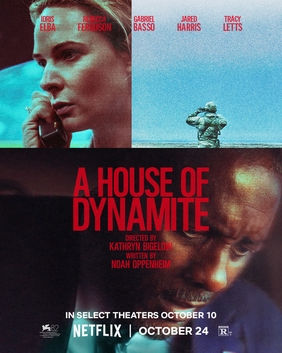THE GOOD LIAR – FASTEN YOUR SEAT BELTS. IT’S GOING TO BE A BUMPY NIGHT
- andy8534
- Sep 2, 2024
- 4 min read
Updated: Feb 3
Each screenplay serves three masters: the story, the characters, and the writer (or filmmaker). And if all three are equally satisfied, the script should be in equilibrium… with engaging characters, an airtight plot, and a happy writer. While the former two are apparent, the latter is tricky, as it only rears its head when it doesn’t work, i.e., when the writer’s, filmmaker’s, or producer’s objectives disregard the story's or the character’s needs.
Hello, dreaded bumps. Coincidences, info dumps, convenient plot events, stilted dialog, plot holes, contrived character choices, inconsistencies, wrong vernacular, darlings, etc., commit the worst possible offense…they take us out of the story.
The Good Liar starts with two septuagenarians, Roy and Betty, who meet on an online dating site and start hanging out. Roy feigns a bad knee, which prompts Betty to invite him to stay at his house and eventually move in. Betty’s grandson Stephen opposes this and Roy, as he is suspicious of Roy’s motivation. He eventually joins them on a trip to Berlin, where they confront him about his real identity, namely Hans Taub. Roy confesses that he stole the deceased Roy’s identity to escape post-WW2 Germany. Betty believes him and dismisses Stephen's objections.
Between this, we learn that Roy is a con artist who sets up scams with some pretend Russian investors and secret agents. He has no problem using deadly force to deal with opponents when he shoves a con in front of a subway car.
Roy and Betty transfer their money into the joint account. However, after returning to his place, Roy discovers that he no longer has the keypad needed to access the account. When he returns to Betty's house to reclaim it, he finds Betty waiting for him in an empty house.
Betty reveals that she, too, is not who she claims she is. Her real name is Lili Schroeder, a German whom Roy (as Hans) tutored when they were teens and whom Roy raped, after which he was humiliated by her father and kicked out of the house. As a reaction, Hans denounced Lili's father, who was then executed by the Nazis, which drove Lili's mother to commit suicide.
Betty/Lili has been aware of Hans/Roy's con all along and takes all of Roy's money out of their joint account, leaving him only enough to pay back the victims of his earlier con. In a last-ditch effort, Roy attacks her – but he is confronted by some of his former criminal associates and cons. Roy refuses to pay them back, is beaten up, suffers a stroke during the fight, and ends up in a hospital, unable to move or talk.
The Good Liar could have been a Hitchcock-level story… set in London, with a twisty plot and a stellar cast. But unfortunately, it suffers from a handful of bumps.
BUMP 1 - THE STAY
Betty invites Roy to stay at her place soon after they meet. This is convenient for the plot, but it feels too early and not genuine. Instead of faking a weak knee, a genuine slip and fall or other more realistic mishaps could have made this event feel real.
BUMP 2 - THE ACCOUNT
Roy is pushing a joint account. This too felt too soon and not genuine. If Betty was a complete pushover and weak, this may have worked, but Betty comes off as pretty smart and so it felt like another convenient plot device. People who have recently met don’t usually join their finances. This event needed some additional work to make it plausible.
BUMP 3 - THE SEX
No sex. After they move in, Betty evades all of Roy’s advances. At the end of the film, we understand why --he raped her decades ago-- but in the moment it felt off. They’ve moved in together, traveled together, and shared finances…intimacy is a logical expectation, and Betty’s reluctance should have rung some alarm bells for Roy. It seems like a missed opportunity for heightened drama. Perhaps a scene where Betty has to get drunk to endure it, and in the end, can’t go through with it.
BUMP 4 - THE TONE
Tone shift. The story starts light, with cozy suspense and some dark humor. It ends with childhood rape. This tonal shift is not smooth. Seeing Roy off a guy in the middle doesn’t help this, either. It comes too late. A possible solution would be to have Roy do some violent and nefarious activity at the story's beginning. Then we’d know this is dark and can suspend our expectations for the more lighthearted parts.
BUMP 5 - THE SUSPENSE
The final bump goes hand in hand with (4)... not knowing Betty’s story earlier. Hitchcock famously said, ‘If you give the audience a surprise, they will have a few seconds of excitement, but if you give them suspense, they’ll be entertained for a long time.’ It's not that The Good Liar lacks suspense, but it misses riding the suspense all the way home. As written, Lili’s backstory comes at the very end, ties the story, and explains Betty’s motivation. And while it achieves those goals, I’d argue that if we took the heightened drama from bump 3 and combined it with a flashback of the rape during the attempted drunken sex scene, we would have set up Betty’s secret harboring major trauma, which would raise the suspense as well as help even the tone. We wouldn’t need to know that Roy was the rapist, leaving this bit for the final reveal.
Screenwriting and filmmaking are damn hard…while pointing out issues after the fact are easy. Nevertheless, The Good Liar could have been bump-free with just a few script-level tweaks.
Director: Bill Condon
Writer: Jeffrey Hatcher
Based on a novel by Nicholas Searle




